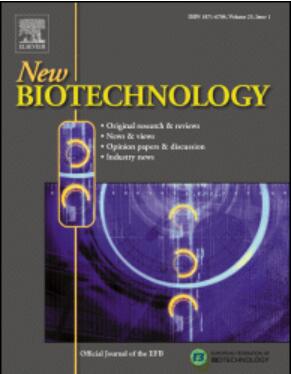Viability assessment and biomass valorization of recombinant Komagataella phaffii
IF 4.9
2区 生物学
Q1 BIOCHEMICAL RESEARCH METHODS
引用次数: 0
Abstract
Komagataella phaffii has become a key player in biotechnology used for the production of heterologous proteins with numerous GRAS notices and QPS status released in the past years. While most of these descriptions and scientific studies focus on strain engineering, products and cultivation processes, this paper provides fundamental data about the general viability of K. phaffii after post-production biomass treatments and co-incubations with non-sterile soil and water samples. A comparison of different K. phaffii strains uncovered a high thermal sensitivity for all tested strains, which was further enhanced under alkaline conditions. A rapid reduction in the viable cell number started at approx. 52 °C and terminated in a full loss of 109 viable cells per milliliter within seconds at 70 °C. Survival rates of untreated non-GMO and GMO K. phaffii strains in water- and soil-slurry-microcosms demonstrated that the number of viable K. phaffii cells decreased rapidly and comparably to a Saccharomyces cerevisiae reference. No mating events were detected under these environmental conditions. These findings supported assumptions that K. phaffii is highly specialized and not a ubiquitous microorganism as described for other yeasts. Finally, intrigued by the low survival outside optimal laboratory conditions, K. phaffii biomass was evaluated in mesophilic anaerobic digestion processes for energy production. Enhanced methane yields and a concomitant loss of viable K. phaffii cells were demonstrated.
重组法菲Komagataella phaffii的活力评价与生物量增值。
Komagataella phaffii已成为生物技术中用于生产外源蛋白的关键参与者,在过去几年中发布了许多GRAS通知和QPS状态。虽然这些描述和科学研究大多集中在菌株工程、产品和培养过程上,但本文提供了法菲氏菌生产后生物量处理和与非无菌土壤和水样共孵育后总体活力的基础数据。通过对不同菌株的比较发现,所有菌株都具有较高的热敏性,在碱性条件下进一步增强。活细胞数量的迅速减少开始于大约。52°C, 70°C时,以每毫升109个活细胞在数秒内完全丧失而终止。未经处理的非转基因和转基因法菲梭菌菌株在水和土壤浆液微生物中的存活率表明,活的法菲梭菌细胞数量迅速下降,与酿酒酵母菌相比较。在这些环境条件下,没有发现交配事件。这些发现支持了这样的假设,即菲氏K.是高度特化的,而不是像其他酵母那样普遍存在的微生物。最后,考虑到最佳实验室条件外的低存活率,研究人员在中温厌氧消化过程中对菲氏K. phaffii生物量进行了评估。甲烷产量的增加和伴随的活的菲氏k细胞的损失被证明。
本文章由计算机程序翻译,如有差异,请以英文原文为准。
求助全文
约1分钟内获得全文
求助全文
来源期刊

New biotechnology
生物-生化研究方法
CiteScore
11.40
自引率
1.90%
发文量
77
审稿时长
1 months
期刊介绍:
New Biotechnology is the official journal of the European Federation of Biotechnology (EFB) and is published bimonthly. It covers both the science of biotechnology and its surrounding political, business and financial milieu. The journal publishes peer-reviewed basic research papers, authoritative reviews, feature articles and opinions in all areas of biotechnology. It reflects the full diversity of current biotechnology science, particularly those advances in research and practice that open opportunities for exploitation of knowledge, commercially or otherwise, together with news, discussion and comment on broader issues of general interest and concern. The outlook is fully international.
The scope of the journal includes the research, industrial and commercial aspects of biotechnology, in areas such as: Healthcare and Pharmaceuticals; Food and Agriculture; Biofuels; Genetic Engineering and Molecular Biology; Genomics and Synthetic Biology; Nanotechnology; Environment and Biodiversity; Biocatalysis; Bioremediation; Process engineering.
 求助内容:
求助内容: 应助结果提醒方式:
应助结果提醒方式:


